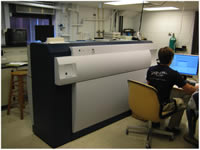Founded by NIH in 2010 (S10 RR027109 A), installed April 2011.
 Located in 41 Noyes Lab, the UltrafleXtreme is available for researchers self-use after training. If you want to use it, contact Furong Sun by e-mail frs@illinois.edu or phone 217-333-2545.
Located in 41 Noyes Lab, the UltrafleXtreme is available for researchers self-use after training. If you want to use it, contact Furong Sun by e-mail frs@illinois.edu or phone 217-333-2545.
The UltrafleXtreme incorporates next-generation MALDI-TOF and TOF/TOF technology:
- The innovative smartbeam-II™ laser enables ultra-high data acquisition speed in both MS and MS/MS at full systems performance. The well-established proprietary smartbeam laser provides unprecedented analytical and matrix flexibility in workflows from protein tissue imaging, intact proteins analysis, biologics or oligo QC, to LC-MALDI proteomics - all fully enabled at 1-1000 Hz repetition rates.
- Bruker's patented smartbeam technology is already widely accepted as the most viable MALDI imaging laser technology. The ultrafleXtreme now enables laser focus diameters down to 10 µm for high spatial resolution imaging without pixel overlap. Importantly, outstanding spectral quality and signal intensity are maintained at even the smallest laser beam diameters.
- Broadband mass resolving power up to 40,000 enables precision proteomics via Bruker’s unique PAN™ technology for highest mass resolution across a very broad mass range, not just at a selected optimum.
- The novel FlashDetector™ combined with a new 4 GHz digitizer and latest advances in electronics provide unmatched mass resolving power up to 40,000 and 1 ppm mass accuracy for highest confidence.
- The novel and unique laser-irradiation self-cleaning MALDI Perpetual™ Ion Source ensures robust, long-term highest-performance operation. Very long MALDI laser lifetime in combination with automated source cleaning in just minutes leads to high uptime and low maintenance costs.
- Latest TOF/TOF technology: The high efficiency and sensitivity of the LID-LIFT process delivers MS/MS spectra with nominal mass resolution for peptides. Typically, full MS/MS data sets can be acquired from low fmol levels within seconds. The Bruker bioinformatic software is perfectly adapted to analyze and visualize the match between the raw spectra and annotated peptide and protein structures
As a result, proteins can be identified with high confidence with unmatched ease.
--- Adopted from Bruker Daltonics website.